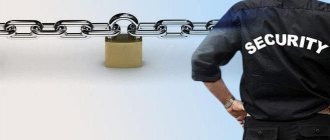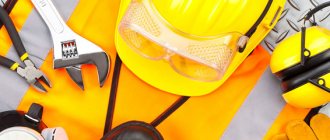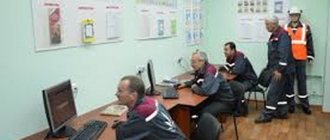The employer has a lot of responsibility to the employee in terms of creating safe working conditions, complying with the rules, standards for issuing PPE, including the provision of special clothing, safety footwear and other personal protective equipment.
And I will also immediately answer a frequently asked question: “is the employee obliged to compensate for the money spent by the employer on the purchase of personal protective equipment.”
No, not obliged, if only for damage.
In order not to violate the law (Article 221 of the Labor Code of the Russian Federation), the employer must, at his own expense, ensure the timely issuance of PPE. In addition to this, there is also their storage, washing, drying, repair and replacement, but more on that a little later.
Who is entitled to receive protective clothing?
To begin with, I would like to especially note that all purchased workwear, safety footwear and personal protective equipment must be certified or have a declaration of conformity with TR CU 019/2011 “On the safety of personal protective equipment”.
Leave copies of certificates from each delivery of workwear and keep them in a folder. The inspector, coming with an inspection, can check their presence. The employer is obliged to provide workers in professions whose activities are related to:
- harmful and dangerous working conditions;
- special temperature conditions;
- pollution.
It turns out that not only blue-collar workers should be provided with free PPE, but also managers and engineers who, while working, visit places where various types of pollution are possible.
What to do with contractors who may work on the territory of your enterprise, who should issue PPE to employees?
Employees of third-party organizations must be provided with special clothing and personal protective equipment at the expense of their employer (clause 18 of Order No. 290n of the Ministry of Social Health Development); special clothing is not required to be issued.
The following also have the right to receive special clothing:
- trainees of your company;
- employees who are temporarily transferred to another job;
- students studying under a student agreement.
Standards for issuing PPE
In order to understand in what quantity and what kind of protective equipment are required, it is necessary to use the standards for issuing workwear; for each production and each profession their own lists have been developed.
Let me give examples of some of them:
- Standards for issuing PPE in construction, approved by order of the Ministry of Health and Social Development of Russia dated July 16, 2007 No. 477.
- Standards for issuing PPE for organizations in the food, meat and dairy industries, approved by Order of the Ministry of Health and Social Development of Russia dated December 31, 2010 No. 1247n.
- Standards for issuing PPE for workers employed in metallurgy, mechanical engineering and transport production, approved by Order of the Ministry of Health and Social Development of Russia dated December 14, 2010 No. 1104n.
- The standards for issuing PPE to workers in the trade and service sector were approved by order of the Ministry of Health and Social Development of Russia dated October 3, 2008 No. 543n.
- And so on... for each position you can find a list of necessary workwear with regulated wearing periods.
There is also a document that defines the issuance standards for workers in cross-cutting professions - this is Order of the Ministry of Labor No. 997n dated December 9, 2014.
It takes precedence over the standards of individual industries for the issuance of workwear, and the positions specified in it must be provided with PPE, even if they are not specified in the industry standards!
There are a number of additional conditions under which the issuance of protective equipment against harmful factors is required, such as:
- working with high noise levels (headphones);
- work at height (safety harness);
- outdoor work in adverse weather conditions (raincoat);
- working outdoors in winter (insulated workwear);
- work in regions where blood-sucking insects appear in summer (repellents, encephalitis suits).
For each region, wearing protective clothing in winter is set at its own time depending on the climate zone. Moreover, the time period for wearing PPE used in special temperature conditions includes the time of their organized storage.
There are five of them in total from I to special. You can find your region and determine the climate zone here.
Only when the appropriate time of year arrives is the employee given seasonal protective equipment, and at the end the employer must organize storage.
What special clothing is required for the driver?
The question of whether drivers are required to wear special clothing is answered by standards that stipulate that the driver’s special clothing should be comfortable and not distract from driving.
Varies depending on the specifics of the activity. Standard set includes:
- anti-pollution suit;
- cloak;
- signal vest;
- boots or boots made of leather with a protective toe cap (demi-season and winter);
- rubber boots with protective toe caps;
- suit with insulated lining;
- felt boots with rubber soles;
- several types of gloves, including insulated ones.
Procedure for issuing PPE
First you need to know the height and size of your employees. This information is determined from the employee’s words and entered into the PPE issuance card.
No matter how funny it may sound, it must correspond to the gender; intersectoral rules for providing workers with special clothing, special shoes and other personal protective equipment (Order No. 290n dated 06/01/2009) stipulate this in clause 12.
All issuance must be recorded in a personal PPE issuance card.
On the front side are entered the names of workwear, safety footwear and protective equipment, which are provided for by the standards developed and approved by the head of the enterprise. The reverse side of the personal PPE card is filled out upon issue.
The employee's signature on receipt of work clothes is required.
It is now popular to maintain an electronic form of a workwear issuance card, which is also allowed by law, but many continue to work the old fashioned way.
The distribution of work clothes and safety shoes to employees is carried out by the warehouse, and a labor protection specialist monitors compliance with standards and the correctness of maintaining cards.
To provide clarity on the wearing period, the amount of workwear issued per year, as well as where this information came from, a list of issuing workwear, safety footwear and personal protective equipment according to your staffing schedule is being developed. The list must be agreed upon with the trade union (if there is one) and approved by the head of the enterprise.
The service life of PPE is regulated by regulations and cannot be extended, as this may worsen the working conditions of workers.
And an employer cannot simply replace one type of personal protective equipment with another. Only by agreeing on this replacement with the trade union body and the replaced PPE should be equally protected.
Remote training and testing in occupational safety
Rules for distance learning on labor protection
Registration sheet - application for distance learning on labor protection
Training materials for occupational safety training
Topic 0. Basic provisions of labor law Topic 1. Legal support for labor protection Topic 2. Organization of work on labor protection in an organization Topic 3. Dangerous and harmful production factors Topic 4. Safe performance of individual works Topic 5. Organization of safe operation of lifting mechanisms and vessels pressure Topic 6. Fire safety
Topic 7. Personal protective equipment
- 7.1. Types of personal protective equipment for workers
- 7.2. The procedure for providing workers with personal protective equipment
Topic 8. Accidents at work Topic 9. Providing first aid to victims at work
7.2. The procedure for providing workers with personal protective equipment
As a result of studying this section you will know:
- Obligations of the employer to provide employees with personal protective equipment;
- The procedure for filling out applications, storing and issuing special clothing, special shoes and other personal protective equipment;
- Responsibilities of workers regarding the use of PPE.
List of basic documents required when studying the section:
- Labor Code of the Russian Federation. Federal Law of December 30, 2001 No. 197-FZ.
- Order of the Ministry of Health and Social Development of Russia dated January 27, 2010 No. 28n “On amendments to the Intersectoral Rules for Providing Workers with Special Clothing, Special Footwear, and Other Personal Protective Equipment, approved by Order of the Ministry of Health and Social Development of the Russian Federation dated January 27, 2010”
- Decree of the Government of the Russian Federation of August 13, 1997 No. 1013. On approval of the list of goods subject to mandatory certification and the list of works and services subject to mandatory certification.
- Resolution of the State Standard of the Russian Federation dated June 19, 2000 No. 34. On the approval and implementation of rules for certification of personal protective equipment.
- Order of the Ministry of Health and Social Development dated 01.06. 2009 No. 290 n “On approval of intersectoral rules for providing workers with special clothing, special footwear and other personal protective equipment.”
Related to this section:
Section 2.2 Organization of work on labor protection.
Section 7.1 Types of personal protective equipment for workers.
The procedure for providing employees of the organization with personal protective equipment (PPE)
The employer is obliged to provide
(Article 212 of the Labor Code of the Russian Federation):
Purchasing and issuing at your own expense
certified: special clothing, special shoes and other personal protective equipment, closing and neutralizing means in accordance with established standards for workers engaged in work with harmful and (or) dangerous working conditions, as well as in work performed in special temperature conditions or related to pollution.
Not providing
workers PPE is considered as
a violation
by the employer of labor protection legislation.
Workers are issued certified personal protective equipment, flushing and neutralizing agents in accordance with the standards in the manner determined by the Government of the Russian Federation (Article 221 of the Labor Code of the Russian Federation).
These standards are the Standard Industry Standards
free provision of special clothing, special shoes and other personal protective equipment to employees.
Responsibilities for developing and approving standard standards for issuing PPE were assigned to the Russian Ministry of Labor.
Model Industry Standards
provide for the provision of personal protective equipment to workers, regardless of which sector of the economy the production, workshops, areas and types of work belong to, as well as regardless of the forms of ownership of organizations and their legal forms.
The employer is obliged:
- Organize proper control over the correct use of personal and collective protective equipment by employees;
- Ensure that workers and employees actually use the special clothing, special shoes and other personal protective equipment issued to them during work;
- Do not allow the use of unrepaired, contaminated workwear;
- Ensure regular testing and inspection of the serviceability of personal protective equipment (respirators, gas masks, self-rescuers, safety belts, mosquito nets, helmets, etc.), as well as timely replacement of filters, glasses and other parts with reduced protective properties. After testing, a mark (stamp, stamp) must be made on the personal protective equipment indicating the timing of the subsequent test;
- Organize proper care of personal protective equipment. Promptly carry out dry cleaning, washing, repair, degreasing and dust removal of special clothing, as well as repair, degassing, decontamination and neutralization of special footwear and other personal protective equipment;
- Instruct workers and employees when issuing personal protective equipment such as respirators, gas masks, and self-rescuers. Safety belts, mosquito nets, helmets and some others.
The employer is obliged to replace or repair
special clothing and special shoes that have become unusable before the end of their wearing period for reasons beyond the control of the employee.
In the event of loss or damage to personal protective equipment in designated storage areas for reasons beyond the control of employees, the employer is obliged to issue
im other personal protective equipment fixes.
The employer, at his own expense, is obliged, in accordance with established standards, to ensure the timely issuance of
special clothing, special shoes and other personal protective equipment, as well as their storage, washing, drying, repair and replacement (Article 221 of the Labor Code of the Russian Federation).
In case of failure
employee with personal and collective protective equipment (in accordance with the standards), the employer
does not have the right
to demand that the employee perform labor duties and is obliged to pay for downtime arising for this reason in accordance with the legislation of the Russian Federation (Article 220 of the Labor Code of the Russian Federation).
The issuance of materials for their production or sums of money for their purchase in exchange for special clothing, special footwear is not permitted.
PPE is issued to employees for a certain period of time
, provided for by the Standard Industry Standards, with recording of the fact of issuing each of them in a personal card by size, height, separately for male and female models.
For each workshop (production, site) PPE is indicated for use in emergency situations and when performing one-time hazardous work. These personal protective equipment are not recorded on personal cards.
Personal protective equipment issued to employees must correspond to the nature and conditions of work and ensure labor safety.
It is not allowed to purchase and issue personal protective equipment to employees without a certificate of conformity
.
Domestic and foreign suppliers of personal protective equipment are required to have a Russian certificate of conformity
.
The rules of procedure and the procedure for carrying out mandatory certification of personal protective equipment are regulated by Decree No. 34 of June 19, 2000 “On the approval and implementation of the rules for certification of personal protective equipment.”
The list of goods, works and services subject to mandatory certification also includes personal protective equipment.
The employer has the right:
Taking into account the opinion of the elected body of the primary trade union organization or other representative body of workers and their financial and economic situation, establish standards
free provision to employees of special clothing, special shoes and other personal protective equipment, which improves the protection of workers from harmful and (or) dangerous factors present in the workplace, as well as special temperature conditions or pollution compared to standard standards (Article 221 of the Labor Code of the Russian Federation).
For example: overalls, a cotton suit with a cotton suit or robe and, conversely, a canvas suit with a cotton suit with fire-retardant or water-repellent impregnation, leather boots (low boots) with tarpaulin boots and, conversely, felt boots with tarpaulin boots.
In cases where personal protective equipment is not specified in the Standard Industry Standards (safety belt, self-rescuers, antiphons, etc.), they can be issued to employees based on workplace certification
depending on the nature of the work performed, they are worn for a period of time - until worn out or as duty workers and can be included in collective agreements and agreements.
When concluding an employment agreement (contract), the employer familiarizes employees with the Rules for providing employees with personal protective equipment and informs them about the personal protective equipment they are entitled to.
Special clothing, special shoes and other personal protective equipment issued to workers and employees are considered the property of the enterprise and are subject to mandatory return
:
- Upon dismissal;
- When transferring to another job in the same company;
- At the end of the wear period, replace the received new one.
The periods for wearing special clothing, special shoes and other personal protective equipment are established on a calendar basis and are calculated from the date of their actual issue to workers and employees. At the same time, the period for wearing warm special clothing and warm special shoes also includes the time of their storage in the warm season.
The employee is obliged to correctly use the funds issued to him
individual and collective protection (Article 214 of the Labor Code of the Russian Federation).
During work, workers and employees are required to use special clothing, special footwear and other personal protective equipment issued to them.
Prohibited
upon completion of work, workers and employees must take special clothing, special shoes and other personal protective equipment outside the organization.
In some cases, where, due to working conditions, the specified procedure cannot be observed (at logging sites), personal protective equipment may remain with workers during non-working hours, which may be stipulated in collective agreements or in internal labor regulations.
Workers must:
- Treat the personal protective equipment issued for their use with care;
- Promptly notify the employer of the need for repairs, washing, dust removal, etc.
Students of any form of training, industrial training masters, as well as workers performing temporary work, are provided with personal protective equipment in accordance with the generally established procedure for the duration of this work.
Workers combining professions or constantly performing combined jobs, in addition to the personal protective equipment issued to them for their main profession, must additionally be issued with other types of personal protective equipment provided for by the Model Industry Standards for the combined profession.
Control questions
1. Is the employer always obliged to provide free special clothing, special shoes and other personal protective equipment before allowing an employee to work?
a) Only if the employee performs work under hazardous working conditions, as well as during work performed in special temperature conditions or associated with pollution, if these personal protective equipment are provided for by standards approved by the resolutions of the Ministry of Labor of Russia.
b) Not always.
c) Always.
2. Whose property does special clothing, special shoes and other personal protective equipment become after they are issued to workers and employees?
a) Special clothing is the property of the employee, collective protective equipment and other personal protective equipment are the property of the enterprise.
b) The property of the enterprise.
c) The property of the employee.
3. When purchasing, is it necessary to check the availability of a domestic certificate of conformity for foreign-made personal protective equipment?
a) Not necessary, a certificate from the country of origin is sufficient.
b) Mandatory, even if there is a certificate from the country of origin.
c) It is advisable to have a domestic certificate.
4. Does the employer have the right to establish improved standards for the free issuance of personal protective equipment to employees?
a) No. PPE is issued strictly in accordance with the Model Standards,
b) Yes, but taking into account the opinion of the representative body of workers and
your financial and economic situation.
c) Yes, up to the results of workplace certification and depending on the nature of the work performed.
5. In what cases is an entry not made into a worker’s personal card when issuing PPE?
a) When issuing PPE for use in emergency situations and when performing one-time hazardous work.
b) When issuing PPE without a certificate of conformity.
c) When issuing low-quality PPE.
6. Who takes care of personal protective equipment during their operation (washing, repair, etc.)?
a) All care is provided by and at the expense of the employer.
b) Laundry, minor repairs - the employee himself, the rest - by the enterprise.
c) Repairs, the need for which arose due to the fault of the employee, are carried out by him and at his expense.
7. Is it allowed to issue materials for their production or
sums of money for their purchase in exchange for the required workwear and safety footwear?
a) Not allowed.
b) Allowed in exceptional cases.
c) It is only allowed to replace the finished product with materials for its manufacture (for example, sewing).
8. Is it mandatory to conduct training when issuing personal protective equipment to employees such as respirators, gas masks, self-rescuers, safety belts, and training them in the rules of use?
a) Yes, definitely.
b) There is no need, because On-the-job training will be provided.
9. What are the features of testing and checking the serviceability of personal protective equipment?
They are carried out:
a) in the presence and at the request of the employee to whom they were issued;
b) within strictly established periods;
c) regularly in accordance with established deadlines. After the inspection, a note must be made regarding the timing of the subsequent test.
Tickets for occupational safety testing
Employer's liability
If management refuses to provide employees with free protective equipment, the employee has every right to refuse to perform work.
At the same time, he cannot be brought to disciplinary liability or other penalties. True, many either do not know about this or are silent, because they could lose their jobs.
But the law provides for punishment of such managers in the form of a fine in the amount of:
- for officials and individual entrepreneurs - from 20 to 30 thousand rubles for each employee;
- for organizations - from 130 to 150 thousand rubles for each employee not provided with PPE.
For a repeated violation, the organization can be fined up to 200 thousand rubles, and its work can be suspended for up to 90 days.
Responsibility of workers for damage to personal protective equipment
According to the law, employees also have responsibility; not everything can be pinned on the employer. 
Employees of enterprises must take care of the protective clothing and personal protective equipment issued to them. If the fact of damage or loss of a set of PPE is revealed, they will have to compensate for the corresponding costs. Its use during work is mandatory (Article 214 of the Labor Code of the Russian Federation), otherwise disciplinary action may follow.
Moreover, in compliance with all safety rules - undone buttons or a robe carelessly thrown over the shoulders is considered exactly the same violation as a complete lack of overalls.
Conclusion
In the field of ensuring safe working conditions, a very important element is protective clothing, which helps not only to protect employees from harmful production processes, but also to ensure comfortable working conditions for workers.
In addition, compliance with these simple rules guarantees the correct and rational use of the enterprise’s budget, eliminating overexpenditures and losses due to the absence of workplace injuries and fines.
I wish you efficient and safe work.
If you have any difficulties in developing documents for the correct management of the issuance of workwear and PPE, please contact us and we will sort it out. I provide a full range of labor protection services.
Concept and role of a document
The Regulations on the issuance of workwear (hereinafter referred to as the Regulations) is an internal regulatory document in accordance with which PPE is issued at the enterprise.
Its specific types and provision standards are determined on the basis of federal and regional legislative acts that apply in this area.
The employer has the right to establish in the Regulations the number of kits issued not only strictly in accordance with the requirements of the law, but also in a larger amount. Additionally, the standard periods of its use can be reduced, and the use of more expensive and wear-resistant models can be established. All this depends only on the financial capabilities of the company.
Reducing the standards is not permitted, since this will be considered a worsening of the employee’s situation.
For greater security, it is better to approve and agree on all conditions with the employees’ trade union committee, if such a body exists at the enterprise.
The presence of this document in the company where the workwear is to be issued is a mandatory requirement. Since it will contain all the necessary data regarding the rules and conditions for its provision, all employees during employment should be familiar with it.
Another factor that speaks in favor of drawing up the Regulations is the possibility of saving on tax payments.
All quantitative norms specified in the document can be taken into account when calculating profit for taxation.








